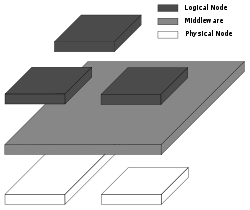In distributed applications

The term is most commonly used for software that enables communication and management of data in distributed applications. An IETF workshop in 2000 defined middleware as "those services found above the transport (i.e. over TCP/IP) layer set of services but below the application environment" (i.e. below application-level APIs).[ citation needed ] In this more specific sense middleware can be described as the hyphen ("-") in client-server , or the -to- in peer-to-peer . Middleware includes web servers, application servers, content management systems, and similar tools that support application development and delivery. [4]
ObjectWeb defines middleware as: "The software layer that lies between the operating system and applications on each side of a distributed computing system in a network." [5] Services that can be regarded as middleware include enterprise application integration, data integration, message oriented middleware (MOM), object request brokers (ORBs), and the enterprise service bus (ESB). [6]
Database access services are often characterised as middleware. Some of them are language specific implementations and support heterogeneous features and other related communication features. [7] Examples of database-oriented middleware include ODBC, JDBC, and transaction processing monitors. [8]
Distributed computing system middleware can loosely be divided into two categories—those that provide human-time services (such as web request servicing) and those that perform in machine-time. This latter middleware is somewhat standardized through the Service Availability Forum [9] and is commonly used in complex, embedded systems within the telecom, defence, and aerospace industries. [10]